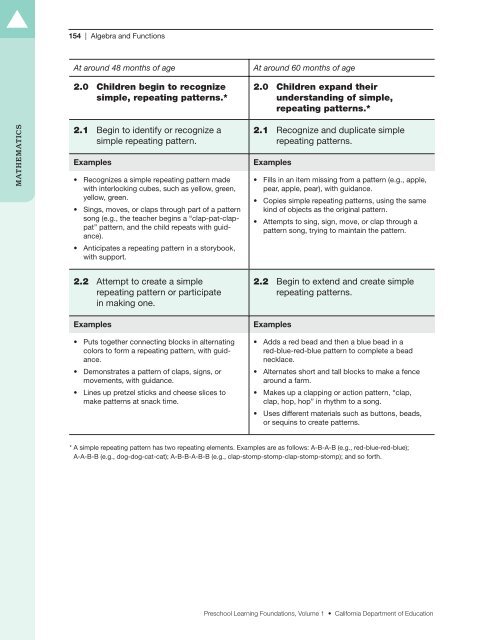California Preschool Learning Foundations - ECEZero2Three ...
California Preschool Learning Foundations - ECEZero2Three ...
California Preschool Learning Foundations - ECEZero2Three ...
You also want an ePaper? Increase the reach of your titles
YUMPU automatically turns print PDFs into web optimized ePapers that Google loves.
MATHEMATICS<br />
154 | Algebra and Functions<br />
At around 48 months of age At around 60 months of age<br />
2.0 Children begin to recognize 2.0 Children expand their<br />
simple, repeating patterns.* understanding of simple,<br />
repeating patterns.*<br />
2.1 Begin to identify or recognize a<br />
simple repeating pattern.<br />
Examples Examples<br />
• Recognizes a simple repeating pattern made<br />
with interlocking cubes, such as yellow, green,<br />
yellow, green.<br />
• Sings, moves, or claps through part of a pattern<br />
song (e.g., the teacher begins a “clap-pat-clappat”<br />
pattern, and the child repeats with guidance).<br />
• Anticipates a repeating pattern in a storybook,<br />
with support.<br />
2.2 Attempt to create a simple<br />
repeating pattern or participate<br />
in making one.<br />
Examples Examples<br />
• Puts together connecting blocks in alternating<br />
colors to form a repeating pattern, with guidance.<br />
• Demonstrates a pattern of claps, signs, or<br />
movements, with guidance.<br />
• Lines up pretzel sticks and cheese slices to<br />
make patterns at snack time.<br />
2.1 Recognize and duplicate simple<br />
repeating patterns.<br />
• Fills in an item missing from a pattern (e.g., apple,<br />
pear, apple, pear), with guidance.<br />
• Copies simple repeating patterns, using the same<br />
kind of objects as the original pattern.<br />
• Attempts to sing, sign, move, or clap through a<br />
pattern song, trying to maintain the pattern.<br />
2.2 Begin to extend and create simple<br />
repeating patterns.<br />
• Adds a red bead and then a blue bead in a<br />
red-blue-red-blue pattern to complete a bead<br />
necklace.<br />
• Alternates short and tall blocks to make a fence<br />
around a farm.<br />
• Makes up a clapping or action pattern, “clap,<br />
clap, hop, hop” in rhythm to a song.<br />
• Uses different materials such as buttons, beads,<br />
or sequins to create patterns.<br />
* A simple repeating pattern has two repeating elements. Examples are as follows: A-B-A-B (e.g., red-blue-red-blue);<br />
A-A-B-B (e.g., dog-dog-cat-cat); A-B-B-A-B-B (e.g., clap-stomp-stomp-clap-stomp-stomp); and so forth.<br />
<strong>Preschool</strong> <strong>Learning</strong> <strong>Foundations</strong>, Volume 1 • <strong>California</strong> Department of Education
















